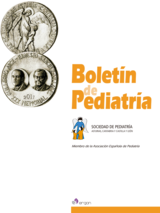Enfermedad de Steinert congénita, la forma más grave de distrofia miotónica tipo 1
C. Sánchez-Villares Lorenzo , P. Domínguez , M. Mateos , A. Hernández Fabián
Bol. Pediatr. 2017; 57 (242): 307 - 310
Introducción. La enfermedad de Steinert congénita es la forma más grave de distrofia miotónica tipo 1, caracterizada fundamentalmente por hipotonía muscular y dificultades para la alimentación. Se hereda de forma autosómica dominante y presenta el fenómeno de anticipación, siendo la penetrancia mayor en generaciones sucesivas y, por tanto, formas más graves. Presentamos un caso de una forma congénita de enfermedad de Steinert en el contexto de familia afecta. Caso clínico. Embarazo controlado con diagnóstico fetal de enfermedad de Steinert (+ 110 copias CTG). Cesárea electiva a las 38 semanas. Apgar 3/7/8. La madre y hermana de 2 años, enfermedad de Steinert. En la exploración destaca hipotonía y debilidad muscular generalizada, con movimientos escasos y facies hipomímica. Reflejo de succión débil e hiporreflexia osteotendinosa. Precisa ventilación mecánica invasiva durante 21 días, posteriormente ventilación no invasiva nocturna hasta los 3 meses de vida. Precisa sonda orogástrica para la alimentación durante el primer mes, después progresivamente tolerancia oral con buena coordinación succión-deglución-respiración y adecuada ganancia ponponderoestatural. Actualmente con 6 meses y medio, presenta retraso del desarrollo neuromadurativo global, persistiendo la hipotonía generalizada. En seguimiento multidisciplinar por especialistas, centro de atención temprana y pediatra de Atención Primaria. Conclusiones. La gravedad de la forma neonatal de la enfermedad de Steinert requiere un eguimiento por el pediatra de Atención Primaria y equipo multidisciplinar para detectar posibles complicaciones que pueden llevar incluso a la muerte temprana. Actualmente el consejo genético es esencial para la planificación familiar y poder evitar la transmisión de la enfermedad a generaciones sucesivas. Por un lado, se puede realizar estudio genético de los embriones de manera preimplantacional para posteriormente transferirlos de manera selectiva sin la mutación, mediante técnicas de fecundación in vitro. Por otro lado, también es posible el estudio genético fetal mediante biopsia corial en el primer trimestre de la gestación, como en el caso presentado, pudiéndose realizar interrupción voluntaria del embarazo.
Congenital Steinert disease, the most serious form of type 1 myotonic dystrophy
Introduction. Congenital Steinert’s disease is the most serious form of type 1 myotonic dystrophy, characterized mainly by muscle hypotonia and feeding difficulties. It is inherited autosomically dominant and presents the phenomenon of anticipation, being the major penetrance in successive generations and therefore, more serious forms. We present a case of a congenital form of Steinert’s disease in the affected family context. Clinical case. Pregnancy controlled with fetal diagnosis of Steinert’s disease (+ 110 CTG copies). Cesarean elective at 38 weeks. Apgar 3/7/8. The mother and sister of 2 years old have also Steinert’s disease. Exploration highlights hypotonia and generalized muscle weakness, with scarce movements and hypomimic facies; weak suction reflexion and osteotendinous hyporreflexia. It requires invasive mechanical ventilation for 21 days, later non-invasive night ventilation up to 3 months of life. It needs an orogastric tube for feeding during the first month, then progressively oral tolerance with good coordination, suction-swallowingbreathing and adequate ponderoestatural gain. Currently, with 6 months of life, she presents a delay in global neuromadurative development, persisting generalized hypotonia. In multidisciplinary follow-up by specialists, early care center and primary care pediatrician. Conclusions. The severity of the congenital form of Steinert’s disease requires follow-up by the primary care pediatrician and multidisciplinary team to detect possible omplications that can lead to even early death. Currently genetic counseling is essential for family planning and to prevent the transmission of the disease to successive generations. On the one hand, it is possible to carry out a genetic study of the embryos in a pre-implantation manner and then transfer them selectively without the mutation, by in vitro fertilization techniques. On the other hand, fetal genetic study by corial biopsy in the first trimester of pregnancy is also possible, as in the case presented, being able to voluntary interruption of pregnancy.
Artículo completo (PDF) (68 kb.)
- Otros
